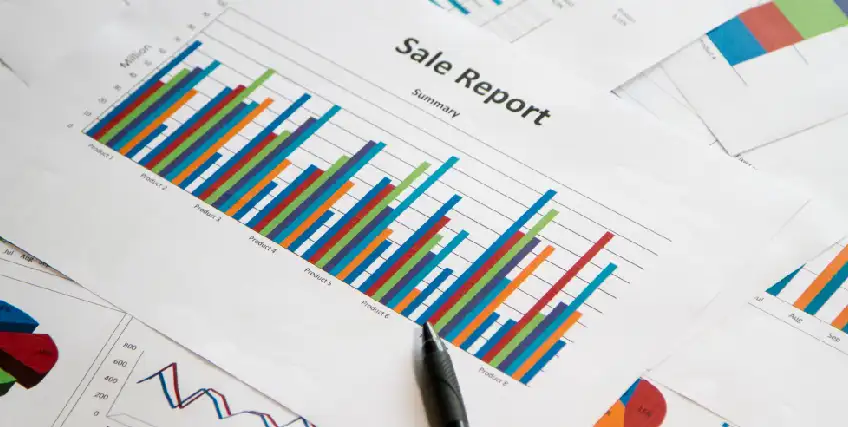Understanding Business Statement of Cash Flows
March 5, 2025 | Last Updated on: March 5, 2025

Whether you are starting a small business, managing a non-profit, or running an international corporation, understanding business statement of cash flows is an invaluable tool for seeing where money is coming and going. These cash flow statements take into account all sources of revenue and payments, helping business owners catch operational warning signs, track funds, and even prove financial stability to lenders and investors.
Here’s a quick summary:
- A business statement of cash flow is a financial analysis of the company’s operating, investing, and financing activities.
- This document summarizes how efficient a company’s operations and strategy are at any given time.
- Operating cash flow is a comparison of a company’s incoming and outgoing transactions.
- Cash flow statements are commonly used by small business owners, lenders, accountants, and investors to evaluate a business’s financial health.
- These financial statements can also be used to understand cash generation, determine future business strategy, and assess the company’s ability to meet financial obligations.
What is a Statement of Cash Flow?
A business statement of cash flow, also known as a cash flow statement, is a standard summary showing a company’s free cash flow, both incoming and outgoing, over a defined period of time. Generated by nonprofit organizations and for-profit businesses alike, this document provides an at-a-glance summary of the company’s liquidity, solvency, and overall financial health to business owners, lenders, and other interested parties.
For a small business to succeed, a business owner must have a thorough understanding of how each financial transaction — such as collecting revenue and making debt payments — affects the overall financial position and net cash flow of the company. Understanding financial statements is an efficient way for entrepreneurs to quickly assess their business’s performance and make informed decisions going forward.
There are many financial reports used in business, but these are the three most common:
- Balance Sheet — A balance sheet quickly shows users how much a business is worth at a certain date by listing all assets (what the business owns), liabilities (what the business owes), and the owner’s equity in the company.
- Income Statement — Also called a profit and loss (P&L) statement, an income statement shows a business’s revenue (money coming in), expenses (money going out), and profit (amount of money left over once all financial obligations are met). Income statements are generated for a specific period of time, typically to show monthly, quarterly, or annual activity.
- Statement of Cash Flows — A cash flow statement shows changes (inflows and outflows) in a business’s cash and cash equivalents over time. Financial transactions on the cash flow statement are broken down into one of three categories: operating, investing, or financing activities.
Each financial report can be used alone, and no one statement is considered more valuable than the others. A company’s financial health is best assessed by looking at two or more types of statements, using the provided information to analyze and adjust business activities and goals.
Ways to prepare a cash flow statement
Two methods can be used to prepare a business statement of cash flow. Both methods are recognized by the standardized accounting industry guidelines, or Generally Accepted Accounting Principles (GAAP).
- Direct method — This method shows cash activity by listing the total cash coming in and going out of the business, and calculates cash flow by subtracting outflows from inflows. The direct method requires accounting software or manual internal processes to track cash receipts and payments.
- Indirect method — This method shows cash outflows as they relate to profit, providing users with a reconciliation ratio of cash flow to net income. This method also factors depreciation for fixed assets, non-cash items, and capital expenditures — like real estate and equipment — into the presented cash flow.
Cash flow statements are typically generated monthly, quarterly, or annually depending on their use.
What’s on the Statement of Cash Flows?
As mentioned, a cash flow statement categorizes transactions into three categories. Separating cash into these categories helps business owners see where income is coming from and how it’s being used, as well as identify areas where the business can improve or increase cash flow.
Cash from operating activities
The movement of money from operating activities appears first on a cash flow statement. The operating activities section describes money that is made or spent during ordinary operations, like providing goods and services, or covering monthly operating expenses as described in the initial business plan. Any changes in savings or checking account balances, current assets, depreciation, inventory, current liabilities, and accounts payable can impact the results of this section of the cash flow statement.
Cash flow from operating activities is broken down into inflows and outflows in order of liquidity. This includes:
Cash from operating activities – cash inflows
- Sales revenues
- Money collected in exchange for services provided
- Commissions and royalties
Cash from operating activities – cash outflows
- Monthly rent for office space, studio area, retail store, or restaurant space
- Utility expenses
- Sales taxes, income taxes, and payroll taxes
- Payments to vendors and suppliers
- Employee salaries and wages
- Interest payments
- Operating expenses, as included in accrual accounting
Cash flow from investing activities
The next section of the statement of cash flows is operating activities, which shows the movement of money from changes in business assets. Since the cash flow statement helps entrepreneurs analyze cash flow from assets, much attention is given to the investing activity section.
Examples of the changes in cash that get categorized as cash flow from investments include:
- Buying and selling assets, like equipment, buildings, and securities
- The amortization of loans and revolving lines of credit to or from vendors and customers
- Merger and acquisition (M&A) activities
- Dividends and interest received from investments
Cash from financing activities
It can be hard to understand the difference between investment activity transactions and financing activities. Just remember that the cash inflows and outflows categorized as financing activities come from capital finance providers, such as investors, banks, and shareholders.
Cash flow from financing activities – cash inflows
- Funds borrowed from a financial institution, such as traditional banks and credit unions
- Proceeds from issuing shares and debentures (long-term debt issued by a government or corporate organizations)
Cash flow from financing activities – cash outflows
- Loan repayments (principal payments on debt borrowed from a financial institution)
- Share repurchase (buying back shares from the marketplace) and debentures
- Dividends paid out to shareholders
What the Statement of Cash Flows tells users about the business
Some users confuse cash flow with profit; while both are important to consider, they are very different business metrics. Cash flow shows the incoming and outgoing flow of funds, and how much cash is available as of a specific date. Profit shows how much of a company’s earnings are left over after all expenses have been subtracted.
In a nutshell, the statement of cash flows highlights the entire path of money as it enters (inflows) and exits (outflows) the organization. It gives managers, business owners, CFOs, and third-party evaluators insight into how and where funds are earned or spent. Access to this summary snapshot of cash transactions gives decision-makers the tools they need to guide expansion, growth, inventory purchases, budgeting, investments, marketing, hiring, and even closing of the business.
In addition to being a valuable tool for business owners, certain external users may request a copy of your business’s statement of cash flow. These may include:
- Creditors — When evaluating a company’s ability to pay current and future debts, the statement of cash flows should show enough cash to take on the new obligation.
- Lenders — Banks and online lenders may request a cash flow statement during the loan application process for business financing options, like a term loan or small business line of credit.
- Investors — Businesses that receive contributions from investors, either in exchange for a percentage of shareholder equity or another repayment arrangement, may request a statement of cash flows.
- Shareholders — Public companies that sell shares through the stock market must be prepared to provide a statement of cash flows as well as show the company’s net income.
Reading the statement of cash flows
Each category on a cash flow statement lists the net result of cash payments for a given period of time. Knowing if you’re looking at one month of activity or three years on this financial report can help you better interpret the business’s cash position.
Some common time frames for comparing cash flow statements include:
- Year-over-Year (YoY) — One complete calendar or fiscal year compared to the previous year
- Quarter-over-Quarter (QoQ) — One complete quarter compared to the previous quarter
- Trailing Twelve Months (TTM) — A rolling comparison of the 12 months immediately preceding
- Multi-Year — A curated comparison of multiple years’ data
No matter your timeframe, net cash flows for each of the three types of activities are represented on the statement as either a positive or negative number. A positive balance indicates that the amount of that actual cash, cash equivalent, or asset has increased, while a negative cash flow balance indicates a decrease in value.
Overall, positive cash flows mean that the operating, financing, or investing activity generated cash profit for the company. Negative balances indicate that the activity cost the business more money than it made.
However, a negative net cash flow balance is not necessarily an indicator of poor performance. For example, making scheduled loan payments may result in negative balances in the financing activities section. However, using cash generated by the business to decrease debt will benefit the business long-term and is generally considered a good use of cash.
Preparing a Statement of Cash Flows
There are several ways to prepare a small business cash flow statement. The exact process or procedure used to generate these financial reports depends on several factors, including personal preference, software capabilities, number of staff members, and the annual revenues of the business.
Some business owners choose to outsource these tasks to an accounting or bookkeeping firm, providing transactional data that’s turned into a financial statement each month. However, many small businesses prepare financial reports, including the cash flow statement, in-house using accounting software like QuickBooks or Sage Intacct.
No matter the method, generating these reports follows the same basic principles:
- Start with the cash balances from the bank account on the first day of the fiscal year or accounting period.
- Add the total annual or periodic cash that came in from operating, investing, and financing activities.
- Subtract the amount of cash used in operating, investing, and financing activities.
- The net cash flow result on the statement should match the ending balance in the bank.
Tips to increase cash flow
One of the most useful aspects of a statement of cash flows is that it shows where money is coming from and going. This information can then be used as a roadmap for making improvements to a business’s performance.
If you are interested in increasing cash flow for your business, the following tips can improve your cash position.
- Boost revenue — Bringing in more money is the most direct way to improve business cash flow. Revenue can be increased by attracting new customers with strategic marketing campaigns or raising prices on the current products and services provided.
- Collect on receivables — A company’s accounts receivable (AR) balance negatively impacts net cash flow. While AR is considered a current asset on the balance sheet, it does not increase cash from operating activities until unpaid invoices are collected.
- Cut costs — Improve cash flows by reducing the costs of goods production or supplies through negotiating better prices with manufacturers and suppliers, or by decreasing the supplies on-hand. Cutting back on ordinary business operations, like labor costs and office rent, will also improve cash flow.
- Consider good debt — Making payments on debt, like small business loans, decreases cash flow, but that’s not always a bad thing. Healthy debt is a great way for businesses to get affordable access to the capital they need for startup costs, large purchases, or working capital. When borrowers receive lump sum payments upfront, it causes a short-term increase in cash flow, so it is important to also understand the impact subsequent payments will have.
Bottom Line
Understanding your company’s cash flow is the first step in achieving and maintaining a healthy financial position. The statement of cash flows is used by business owners to quickly assess how much cash is on hand and how operating, investing, and financing activity impacts the flow of funds.
FAQs
What does a cash flow statement tell you about a business?
A business cash flow statement offers a snapshot of how the company is operating, its solvency and liquidity, and whether it’s generally healthy from a financial perspective. These statements calculate the difference between incoming and outgoing cash payments, demonstrating how much cash a business has on-hand and where its money is going.
Is it okay to have negative cash flow?
Negative cash flow isn’t uncommon, especially for newer businesses or those attempting to expand. A negative cash flow may also be an indicator that the business needs to trim expenses, adjust its marketing strategy, or boost revenue, especially if it’s in the red for multiple years in a row.
Does cash flow include payroll?
Yes, business cash flow calculations and statements should account for all operating expenses, including payroll.
What are the red flags in cash flow statement?
Businesses should keep an eye out for certain warning signs in their cash flow statements, such as a negative cash flow balance, ending calculations that don’t match corresponding bank account balances, rising debt with stagnant (or decreasing) income, and high debt service ratios.




